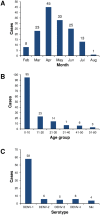Clinical and virological characteristics of dengue in Surabaya, Indonesia
- PMID: 28575000
- PMCID: PMC5456069
- DOI: 10.1371/journal.pone.0178443
Clinical and virological characteristics of dengue in Surabaya, Indonesia
Abstract
Dengue disease is still a major health problem in Indonesia. Surabaya, the second largest city in the country, is endemic for dengue. We report here on dengue disease in Surabaya, investigating the clinical manifestations, the distribution of dengue virus (DENV) serotypes, and the relationships between clinical manifestations and the genetic characteristics of DENV. A total of 148 patients suspected of having dengue were recruited during February-August 2012. One hundred one (68%) of them were children, and 47 (32%) were adults. Dengue fever (DF) and Dengue hemorrhagic fever (DHF) were equally manifested in all of the patients. We performed DENV serotyping on all of the samples using real-time RT-PCR. Of 148, 79 (53%) samples were detected as DENV positive, with DENV-1 as the predominant serotype (73%), followed by DENV-2 (8%), DENV-4 (8%), and DENV-3 (6%), while 5% were mixed infections. Based on the Envelope gene sequences, we performed phylogenetic analyses of 24 isolates to genotype the DENV circulating in Surabaya in 2012, and the analysis revealed that DENV-1 consisted of Genotypes I and IV, DENV-2 was of the Cosmopolitan genotype, the DENV-3 viruses were of Genotype I, and DENV-4 was detected as Genotype II. We correlated the infecting DENV serotypes with clinical manifestations and laboratory parameters; however, no significant correlations were found. Amino acid analysis of Envelope protein did not find any unique mutations related to disease severity.
Conflict of interest statement
Figures






References
MeSH terms
LinkOut - more resources
Full Text Sources
Other Literature Sources
Medical
Molecular Biology Databases
Miscellaneous

